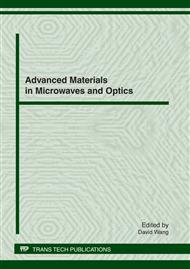[1]
Anderson JE, Factors controlling transpiration and photosynthesis in Tamarix chinensis lour, Ecology, vol. 63(1), 1982, PP: 48-56.
DOI: 10.2307/1937030
Google Scholar
[2]
Liu Bing and Zhao Wenzhi, Ecological adaptability of photosynthesis and water Metabolism for Tamaris Ramosissma and Nitraria Sphaerocarpa in desert oasis Ecotone, Journal of Desert Research, vol. 29, 2009, PP: 101-107.
Google Scholar
[3]
Xu, H., Li, Y. and Xu, G., Ecophysiological response and morphological adjustment of two Central Asian desert shrubs towards variation in summer precipitation, Plant, Cell and Environment, vol. 23, 2007, PP: 399-409.
DOI: 10.1111/j.1365-3040.2006.001626.x
Google Scholar
[4]
Xu G. Q and Li Y, Rooting depth and leaf hydraulic conductance in the tree Haloxyolon ammodendron growis of contrasting at sites of contrasting soil texture, Functional Plant Biology, vol34, 2008, PP: 1234-1242.
DOI: 10.1071/fp08175
Google Scholar
[5]
Jayaraman V and Srivastava SK., The invariance of red-edge inflection wavelengths derived from ground based spectro-radiometer and space-borne IRS-P3: MOS-B data, International Journal of Remote Sensing, 2002, PP: 2741-2765.
DOI: 10.1080/014311602760128125
Google Scholar
[6]
Su P. X., Cheng G. D. and Yan Q. D., Photosynthetic regulation of C4 desert plant Haloxylon ammodendron under drought stress, Plant Growth Regulation, vol. 34, 2007, PP: 139-147.
DOI: 10.1007/s10725-006-9156-9
Google Scholar
[7]
Daniel A. Sims and John A. Gamon, Relationships between leaf pigment content and spectral reflectance across a wide range of specied, leaf structure and developmental stages, Remote Sensing of Environment, vol. 45, 2002, PP: 337-354.
DOI: 10.1016/s0034-4257(02)00010-x
Google Scholar
[8]
Penuelas J, Pinol J, Ogaya R and Filella, Estimation of plant water concentration by the reflectance water index WI (R900/R970), International Journal of Remote Sensing, vol. 19, 1997 PP: 2869-2875.
DOI: 10.1080/014311697217396
Google Scholar
[9]
Suareza, L., Zarco P.J. and V. Gonzalez, Detecting water stress effects on fruit quality in orchards with time-series PRI airborne imagery, Remote Sensing of Environment, vol. 23, 2010, PP: 286-298.
DOI: 10.1016/j.rse.2009.09.006
Google Scholar
[10]
Blicker, P.S., Olson, B.E. and Wraith J. M, Water use and water-use efficiency of the invasive Centaurea maculosa and three native grasses, Plant and Soil, vol. 33, 2003, PP: 371-381.
Google Scholar
[11]
Heschel, M. S., Donohue, K., Hausmann, N., and Schmitt, J. Population differentiation and natural selection for water-use efficiency in Impatiens capensis (Balsaminaceae), International Journal Of Plant Sciences, vol 22, 2002, PP: 907-912.
DOI: 10.1086/342519
Google Scholar
[12]
Fu A. H., Chen Y. N. and Chen Y. P., Changes of stem water potential of Tamarixt ramosissima under drought stress in lower reaches of Tarim River, Chineses Journal of Ecology, vol. 7, 2008, PP: 532-538.
Google Scholar
[13]
Zeng F. J., Andrea Foetzki and Li X. Y. A preliminary study on the effect of irrigation on water physiology of Tamarix ramosisssima in cele oasis, Chinese Journal of Applied Ecology, vol. 11, 2002, PP: 849-863. Linear regression results between WUE and different indices derived Index type Formula λ1 λ2 λ3 RMSE R2 P R ρλ1 455 - - 0. 001 0. 13 0. 007 D ρλ1−ρλ2 1320 1580 - 0. 00091 0. 34 <0. 001 SR ρλ2/ρλ1 1917 1940 - 0. 00079 0. 58 <0. 001 ND (ρλ1−ρλ2)/(ρλ1+ρλ2) 2200 2340 - 0. 00075 0. 56 <0. 001 mSR (ρλ1−ρλ2)/(ρλ1+ρλ2−2ρλ3) 430 2140 2270 0. 00070 0. 51 <0. 001 mND (ρλ1−ρλ3)/(ρλ2−ρλ3) 590 1780 2370 0. 00084 0. 56 <0. 001.
Google Scholar


